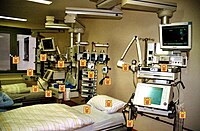
Photo from wikipedia
We constructed and validated a mathematical model of infectious diseases to simulate the impact of COVID-19 nosocomial infection outbreaks outside hospitals. The model was constructed with two populations, one inside… Click to show full abstract
We constructed and validated a mathematical model of infectious diseases to simulate the impact of COVID-19 nosocomial infection outbreaks outside hospitals. The model was constructed with two populations, one inside the hospital and one outside the hospital, and a population diffusion rate k (0 ≤ k ≤ 1) was set as a parameter to simulate the flow of people inside the hospital to outside the hospital. To validate the model, we divided the values of the population diffusion rate k into k = 0–0.25, 0.25–0.50, 0.50–0.75, and 0.75–1.0, and the initial value at the beginning of the simulation was set as day 1. The number of infected people was calculated for a 60-day period. The change in the number of people infected outside the hospital due to the out-break of nosocomial infection was calculated. As a result of the simulation, the number of people infected outside the hospital increased as the population diffusion rate k increased from 0.50 to 0.75, but the number of people infected from 0.75 to 1.0 was almost the same as that from 0 to 0.25, with the peak day being earlier. In future, it will be necessary to examine epidemiological information that has a large impact on the results.
Journal Title: Healthcare
Year Published: 2022
Link to full text (if available)
Share on Social Media: Sign Up to like & get
recommendations!